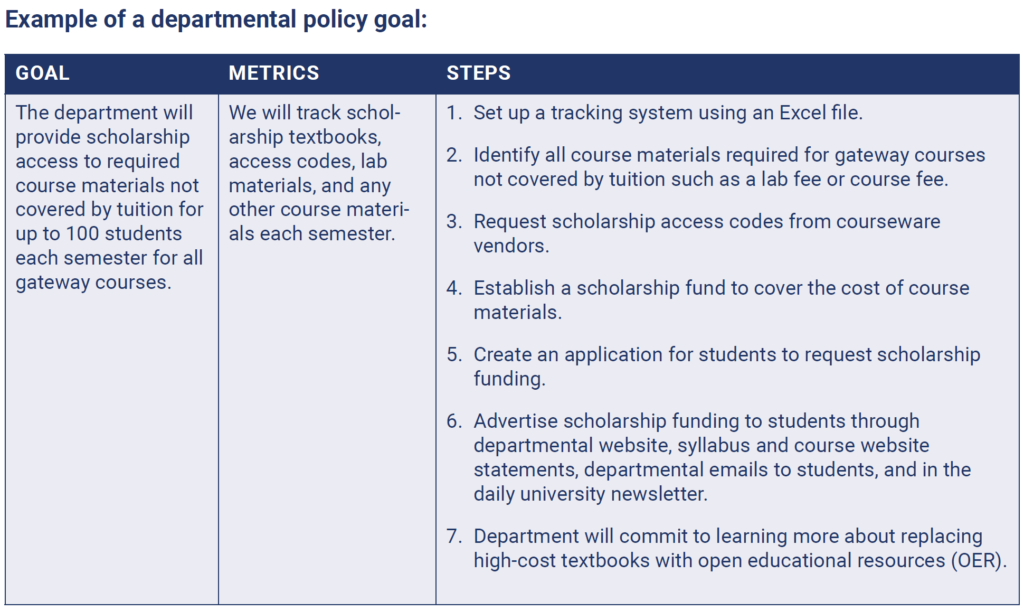Ideally, while working to incorporate equitable teaching practices, you and your colleagues have a strong sense of the existing barriers that need to be confronted. Advancing equity at the departmental level for minoritized and poverty-affected students requires a thorough environmental scan, intentionality, and well-defined measurable goals.
That’s where a departmental equity audit can be useful. A departmental equity audit is a process for identifying the practices, policies, and procedures that create systemic barriers for minoritized and poverty-affected students. It involves benchmarking and assessing the current experiences of students and critically reflecting on the role the department has for creating equity in the college or university.
A process for a departmental equity audit is detailed in Part I of Getting Started With Equity: A Guide for Academic Department Leaders, a new publication from Every Learner Everywhere and Intentional Futures. Each part of the recommended process provides guiding questions, specific advice and examples, and links to supporting resources. (Part II of Getting Started With Equity goes on to offer practical tools and other resources for equity-centered teaching practices. Part III includes briefs for equity-centered teaching in gateway courses in specific disciplines — biology, chemistry, mathematics, psychology, and writing.)
A departmental equity audit can be thought of in three broad phases.
Phase 1: Data collection
The first step of an equity audit is to understand the nature and scope of equity issues in your department. How pressing are the challenges for minoritized and poverty-affected students? More importantly, what needs and barriers are you not aware of?
Data collection may begin with student learning outcomes, and you’ll need to consider ways to disaggregate the learning data available to you to understand the experience of particular groups of students. But as the Getting Started With Equity discusses, there is a risk of too simplistic an approach to that data. The process can tend toward linear views of complex student identities and deficit-centered interpretations that blame students, their families, their economic circumstances, and their race or ethnic culture for national and institutional patterns of academic inequities.
Many departments will particularly want to look at data in the high-enrollment gateway courses that, rather than acting as a welcoming entryway into a field of study, act as a hurdle. Minoritized and poverty-affected students disproportionately have the latter experience in gateway courses.
Along with learning outcomes and other qualitative data, you should work to gather qualitative insights that may reveal the unexpected ways students experience the policies, procedures, and practices in your department. Qualitative insights can come from focus groups, surveys, and course evaluations.
Phase 2: Data interpretation
Of course, interpreting data is subjective, so it’s important to keep in mind that existing perspectives will tend to reinforce existing structures.
In the second phase of your equity audit, your department must consciously work to avoid deficit thinking that centers the experience of students from dominant groups. Deficit thinking tends to assume — and to focus on — a lack on the part of the students who aren’t succeeding academically. As Getting Started With Equity quotes Lindsey Malcom-Piqueux from the Center for Urban Education at the University of Southern California saying, “Equity-minded sensemaking requires a change in mindset, where inequities are viewed as a problem of practice and not as resulting from problem students.”
A key change in that mindset is to focus on what the faculty and staff in your department have control over — teaching and assessment practices, curricula, advising, scheduling, and registration policies, for example. An essential step to making that mindset shift is to get outside help with data interpretation from colleagues elsewhere in the institution. If your college or university has DEI, institutional research, instructional design, and student affairs offices, the specialist experience and expertise from those professionals, alongside the perspectives of faculty, will help to adjust to a non-deficit lens.
Data interpretation should also involve students. That helps avoid making assumptions about their behavior, their capability, and their motivation. The academic and student support professionals mentioned above can advise you on getting student perspectives without the common mistake of asking a few minoritized students to speak for everyone in a racial or ethnic demographic.
Phase 3: Act on the data
The third phase of an equity audit leads to a departmental equity plan. This also must involve students and faculty as co-creators. The plan should have goals that are measurable, should identify the metrics used, and should define milestones reached both in the short term and the long term.
Broken down into those steps, your department may begin to see “quick win” opportunities to remove barriers to access and progress that some of your students face. The example below suggests systemizing how access codes for course materials are matched with the students who need them. And you will see “stretch” goals that may take more time, such as building a scholarship fund or transitioning to open educational resources.

Getting Started With Equity: A Guide for Academic Department Leaders
The equity audit begins the conversation
For many departments, an equity audit will identify a range of pressing needs, emerging needs, and necessary structural changes. Some of them may take years to make progress on. In most cases, progress on an equity plan will require ongoing training and support for faculty. And it’s important to keep in mind that a department acting alone can’t create all the systemic change necessary in the move toward equity.
But a departmental equity audit is an important starting point that can have a tremendous impact on students enrolled in your gateway courses. It offers an opportunity to begin conversations around how academic departments can work toward equity and justice in their curricula and teaching.
Download Getting Started With Equity: A Guide for Academic Department Leaders


